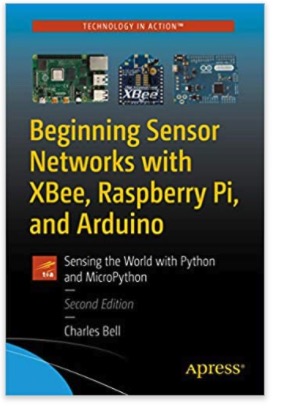Blog
Recent Posts
Sensor Networks with XBee, Raspberry Pi, and Arduino: Sensing the World with Python and MicroPython
Posted by on
This book explains how to build sensor networks with Python and MicroPython using XBee radio modules, Raspberry Pi, and Arduino boards. This revised and updated edition will put all of these technologies together to form a sensor network and show you how to turn your Raspberry Pi into a MySQL database server to save sensor data.
The reader will review the different sensors and sensor networks, including how to build a simple XBee network, walk through building sensor nodes on the XBee, Raspberry Pi, and Arduino and learn how to gather data from various sensor nodes.
The book also examines different ways to store sensor data, including writing to an SD card, sending data to the cloud, and setting up a Raspberry Pi MySQL server to host your data. The reader will learn how to connect to and interact with a MySQL database server directly from an Arduino. Lastly, the book explains how to put it all together by connecting the sensor nodes to the Raspberry Pi database server.
If you want to see how well XBee, Raspberry Pi, and Arduino can get along, especially to create a sensor network, then Beginning Sensor Networks with XBee, Raspberry Pi, and Arduino is precisely the book you need.
- Code your sensor nodes with Python and MicroPython
- Work with new XBee 3 modules
- Host your data on Raspberry Pi
- Get started with MySQL
- Create sophisticated sensor networks
This book is suitable for building or experimenting with sensor networks and IoT solutions, even for readers with little or no programming experience. Another target group includes readers interested in using XBee modules with Raspberry Pi and Arduino and controlling XBee modules with MicroPython.
Raspberry Pi 4 With PICAN3 CAN Bus HAT
fThe Raspberry Pi 4 offers groundbreaking improvements in processor speed, multimedia performance, memory, and connectivity compared to the prior-generation boards while preserving backward compatibility. The Raspberry Pi 4 provides desktop performance comparable to entry-level x86 PC systems.
The PiCAN3 board with SMPS (Switch Mode Power Supply) and RTC provides CAN-Bus capabilities for the Raspberry Pi 4. It uses the Microchip MCP2515 CAN controller with MCP2551 CAN transceiver. Connection are made via DB9 or the onboard 3 way screw terminal.
The Switch Mode Power Supply (SMPS) allows connecting an input voltage range of 6 VDC to 20 VDC suitable for industrial and automotive applications and environments. The SMPS will power the Raspberry Pi plus PICAN3.
Digital Signal Processor Board With One CAN Bus Interface
Renesas Electronics Corporation, a Japanese company providing leading-edge semiconductor solutions, introduced its RX23E-A MCU starter kit for analog evaluation of automation and measurement equipment. It utilizes an onboard CAN Bus driver integrated circuit.The starter kit serves developers working with the CAN-Bus-capable 32‑bit RX23E‑A MCU (micro-controller unit), featuring the analog front‑end (AFE). The package integrates hardware, software, and tools [...]
STM32 XNUCLEO Development Kit - IoT Sensor Pack
The Copperhill Technologies STM32 XNUCLEO Development Kit With IO Shield And Sensors Pack provides a number of sensors, including Gas, Color, Flame, Hall, IR, UV, Laser, Sound, Temperature and Humidity, Tilt, Liquid level, and more. In detail, they are: MQ-5 Gas SensorThe MQ-5 is a high performance gas sensor for detecting butane, propane and methane, and it can [...]
Combined Acceleration Sensor And Gyroscope With SAE J1939 Connectivity
Gemac Chemnitz (Germany) announced their dynamic inclinometer family of products featuring CANopen and SAE J1939 connectivity. The dynamic inclinometers provide angle measurements in moving applications. Combining an acceleration sensor with an angular rate sensor enables inclination measurements with a resolution of 0,01° and an accuracy better than ±2°. The one-dimensional measurement range is 360°, the two-dimensional versions [...]
SAE J1939 CAN Range Of Hydraulic Sensors For OEM Mobile And Industrial Applications
The new SAE J1939 CAN range of hydraulic sensors from Webtec (Milwaukee, WI) are designed for OEM Mobile and Industrial applications where the user needs real-time continuous monitoring of hydraulic flow, pressure and temperature on high-pressure hydraulic systems for closed loop control, to predict imminent hydraulic failure or for diagnostic fault-finding. The CT turbine flow meter range with [...]
 Loading... Please wait...
Loading... Please wait...


